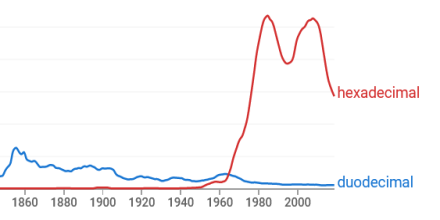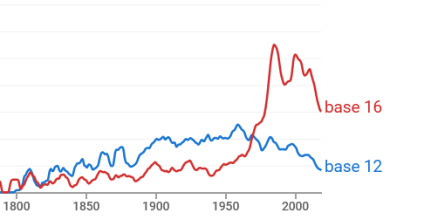I ran across the word duodecimal recently, the Latin-derived term for base 12, and realized it’s been years, maybe decades, since I’d heard that term.
I’ve used hexadecimal explicitly in 30 different blog posts, and implicitly in more, but this is the first time I’ve used duodecimal.
Hexadecimal comes up constantly in application. I suppose duodecimal comes up mostly in teaching, an example of a base that is bigger than 10 but still easy to work with.
Here’s a plot of the relative frequency of “hexadecimal” and “duodecimal” according to Google’s ngram viewer.

The use of the word duodecimal peaked in 1855—I have no idea why—and the word generally declined after that.
Merriam-Webster says that hexadecimal first appeared in 1954, though Google indicates a tiny number of uses before then. Clearly hexadecimal was either coined or became far more commonly used due to the development of computers.
It’s interesting that use of duodecimal rose in the 1950s and 1960s. I imagine this was in part due to people using base 12 as an example to explain base 16. Some of the rise in the 1960s might have been from the “new math” education fad.
If we look at “base 12” versus “base 16” we see that use of “base 12” has declined, but not as much as use of the word “duodecimal” has declined. I suppose hexadecimal is in common use because it’s easy to abbreviate to “hex.” Saying “duo” for base 12 would not be nearly as understandable.


I would guess that base-12 interest was common during the Hollerith code period of modern computing. The standard punch card was marked for digits 0-9, but two (generally unmarked) rows were used for various purposes. It was common for ‘compressed’ or ‘binary’ data to use all 12 rows
History – http://www.dozenal.org/articles/DSA-MyLoveAffair.pdf
Many countries moved away from duodecimal currencies in the 1960’s which be the reason for the spike then
The pound sterling was decimalised in 1971. Before that there were 12 pence per shilling and 20 shillings per pound. So mixed radix arithmetic was imposed upon schoolchildren in the UK and most of the Commonwealth before then.
When I was first exposed to octal and hexadecimal my first reaction was “Oh no! Not again”.
The final decline in duodecimal usage was around that time.
Pure Latin “sedecimal” seems to have been the earliest coinage referring to base 16, first in German and then translated to English c. 1829-30, at least using the same Google Ngram viewer as a source. (Other variants of the purely Latin form aren’t found, refer to other forms of 16, or in one case, a mineral with six-fold and ten-fold faceted vertices.)
I feel like I encounter the word duodecimal regularly, but that may be because I read a fair amount about music theory; there are 12 “pitch classes” (C, C#, D, …) and in serialist music other sets of 12 elements often turn up.
In fact, the peak of interest in total serialism was the 1950s and 1960s, hmm…
A Google Book search of the pre-1953 date mostly finds mis-dated materials. That said, it did find “NBS Report 1036” titled “Preliminary Notes on the System Design of the STATAC-SCOOP Computer” by Alan L. Leiner and internally dated as June 25, 1951. Quoting https://books.google.com/books?id=wSW6K1CpYqkC&pg=PP19&q=hexadecimal :
“The advantages of the binary or hexadecimal system of notation would seem to be, first, compactness. … For example, 12 binary digits or 3 hexadecimal digits are capable of denoting as many as 4,096 address numbers.”
In “Programming and coding handbook for SEAC” by Joseph H. Levin (NBS Report 1984, Sept. 30, 1952) you can read at https://archive.org/details/programmingcodin1984levi/page/26/mode/2up?q=+hexadecimal :
“The words “octal” and “hexadecimal” are hybrid words which have become established through usage. Though actually “octaral” or “octadic”, and “sedecimal” or “hexadecadic” would have been preferable, this Handbook will conform to the established parlance.
Then there’s base 11 for ISBN codes and base 3 for pigs ears. In the 1960s, I had a new math teaching poster – stuff my mom, the English teacher, could get for free – and it used T and E to flesh out base 12.
Duodecimal was introduced by the Romans who used it most often than decimal for fractions, having names for multitudes of duodecimal values including names for 11/12 10/12 and all others down to 1/12 know as an ‘uncia’ and values as small as 1/2304 others between 1/12 and 1/2304. Why 1/2304 is a sub multiple of 12 and 8. The submiltiples of 8 began as the Romans found eighths useful as well as twelfths, and had the word ‘semuncia’ to represent one and a half twelfths (= 1/8). The use of duodecimals persisted in most European counties andost lately in Britain such as 12 inches in a foot, 12 pennies in a shilling. That usage was introduced by Charlemagne as the ‘libre’ of 20 ‘sou’ and the sou of 12 ‘demier’ or pennies. This is the origin of pre-decomal sterling represented by Lsd for poinds, shillings and pence. Furthemore, the latin for 1/12 the ‘uncia’, is the origin of the English words ounce and inch.
Why did the Romans use twelfths for fractions? Because it simplifies calculations versus decimal due to the greater number of divisors of twelve (2 3 4 and 6) than ten (2 and 5). Shame the French academy didn’t choose their first idea of a base twelve numeral system and a system of weights and measures on base 12. Base 12 allows for simpler arithmetic including halves, thirds and quarters with single digits, or 0.6, 0.4 and 0.3 respectively. Multiplication tables are more regular, and division far easier. So please Boris, don’t bring back imperial measures, but adapt them to a rational base 12 number base and call it the Uncial system. Why? The decimal system is named from the Latin word for one tenth ‘decima’, so a base twelve system should be named for the Latin word for one twelfth, ‘uncia’.